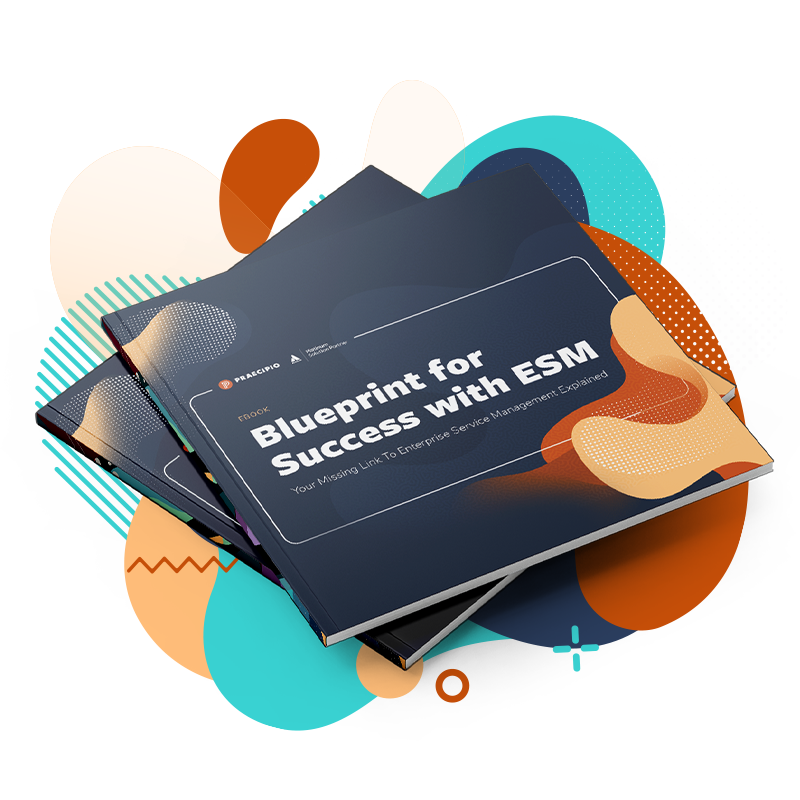Blueprint for Success with ESM
What is Enterprise Service Management (ESM)? Your Missing Link Explained.

What is Enterprise Service Management (ESM)?
In today’s fast-paced business world, speed is everything.
Disjointed tools and siloed teams slow you down—Enterprise Service Management (ESM) solves that by uniting every team on one platform, from IT to HR to finance. This streamlined approach not only accelerates time-to-market by enhancing cross-team communication, but it also ensures that information stays accurate and up-to-date. Customers won’t wait, and neither should you.
By extending the principles of IT Service Management (ITSM) beyond IT, ESM creates a unified environment where every team—whether HR, finance, or legal—can collaborate seamlessly. This enterprise service management strategy not only optimizes internal processes but also improves service delivery and business outcomes through automation and data-driven decision-making. The result is consistent, high-quality service experiences that drive business success both within your organization and externally.
Seamless service experiences are an essential part of any customer-centric business strategy, but they’re just as important for your internal teams and stakeholders. According to Atlassian, “ESM helps define and clarify internal services, creating a holistic approach to processes and workflows that benefit all employees.” 68% of organizations have already implemented enterprise service management, and the $10.5 billion market for ITSM tools continues to grow. Nearly one-third of consumers say they’ll leave a brand after just one negative experience—and that scrutiny applies to internal service experiences as well. Don’t let bad processes put your employee retention at risk.
The Evolution from ITSM to Enterprise Service Management
Simply put, ESM extends ITSM principles to enable better service delivery across all business teams—HR, legal, facilities, marketing, and finance included. ESM isn’t a new concept, but its importance has surged as businesses adapt to remote and hybrid work environments. The days of isolated ITSM are over—ESM is the future, bringing IT’s efficiency to the entire enterprise.
Companies like HunterDouglas, Anytime Fitness, and Nvidia have already implemented enterprise service management strategies to enhance service delivery and operational efficiency. Specific outcomes from adopting ESM tools include improvements in incident reporting, satisfaction levels, and resource optimization.
ESM connects business teams, developers, and IT operations without sacrificing visibility or ease of use. It creates “a universal system of connected work” Forrester, breaking down the silos that separate teams and creating a cohesive workflow that enhances visibility and accelerates decision-making.

Our client saw real gains in operations after we sharpened their end-to-end visibility.
QAD, a global enterprise software company, faced significant challenges with fragmented tools and siloed teams. Each department operated in its own bubble, making collaboration difficult and leading to inefficiencies. QAD consolidated their tools with Jira Service Management, streamlining processes and dramatically improving enterprise-wide communication and collaboration. The result was a more agile organization ready to meet customer demands with speed and precision.
What is Enterprise Service Management?
The extension of IT Service Management (ITSM) principles to enable better service delivery for business teams like Human Resources (HR), legal, facilities, marketing, and finance. Atlassian
ITIL’s Role in Expanding ESM
The ITIL framework has been a cornerstone of ITSM transformation since 1989. With guidance for up to 34 management practice areas, ITIL has always focused on aligning IT services with business needs. In 2019, Axelos released ITIL 4 to meet the demands of modern businesses, emphasizing teamwork, communication, and user-friendly ITSM systems that consider the people behind the processes.
ITIL 4 introduces the Service Value System (SVS), a comprehensive framework that structures how various components and activities collaborate to generate value within an organization.
ESM aligns perfectly with ITIL’s evolution. ITIL 4’s focus on collaboration and communication makes it a natural fit with ESM, helping organizations adopt a more integrated service management approach. Even ITSM governing bodies recognize the power of a more holistic strategy—ESM isn’t just a trend; it’s the future of seamless operations. When employees have a unified experience and the right tools, they can better collaborate across departments, breaking down the silos that often hinder efficiency.
Unifying Service Management for a Better Employee Experience
While much of the focus in service management is on improving customer experience, we can’t overlook the importance of employee experience. Happy, engaged employees are the backbone of any successful organization, and their satisfaction directly impacts the quality of service they provide. Integrating service management capabilities streamlines service delivery processes across various organizational departments, enhancing collaboration among teams and leading to improved operational efficiency and standardized service quality.
This is where enterprise visibility comes into play. Give your teams unprecedented insight into operations across the entire organization, allowing them to make informed decisions, anticipate challenges, and contribute more effectively to overall business strategy.
In today’s business environment, the employee experience is just as important as the customer experience. Gallup’s 2024 State of the Global Workplace Report estimates low employee engagement costs nearly 9% of the global GDP, equivalent to US $8.9 trillion. Enterprise Service Management addresses these challenges head-on by providing a unified platform where all teams can collaborate, share knowledge, and work towards common goals. This isn’t just about making life easier for IT—every department benefits when information flows freely across the organization.
Providing great service experiences starts on the inside – happy employees mean happy customers.
Employee Onboarding Example:
Employee onboarding is a prime example of where ESM can improve cross-functional workflows. A self-service portal empowers employees to independently resolve issues, access relevant information, and manage various IT and non-IT services effectively. Just over half of employees feel satisfied with their onboarding experience (52%), while almost a third describe it as confusing (32%). This confusion often arises because onboarding requires collaboration across multiple departments—HR, IT, payroll, and more. ESM streamlines this process, reducing confusion and improving satisfaction. When your employees start strong, so does your business.
Data silos continue to present challenges for 90% of organizations.
Connectivity Benchmark Report 2022Collaboration is Key
to Break Down Silos
Data silos are one of the most significant barriers to effective collaboration. When teams operate in isolation, with each using different tools and processes, maintaining a consistent business strategy becomes nearly impossible. Miscommunication, duplicated efforts, and delays become the norm rather than the exception.
An integrated service management platform helps streamline service delivery processes by enabling collaboration between various departments, such as operations, development, and business teams. These platforms break down silos, allowing organizations to enhance efficiency and improve service quality across the enterprise.
Enterprise visibility isn’t just about seeing everything; it’s about understanding it. It’s the difference between reacting to issues as they arise and proactively managing your operations to avoid them in the first place. ESM connects the dots across your organization, ensuring that every team, from IT to HR to marketing, has the context they need to work efficiently and effectively.

West Ada School District Takes Data-Driven Approach to Asset Management
The West Ada School District faced significant challenges in managing their assets across a sprawling educational network. By leveraging Atlassian’s tools, they adopted a data-driven approach to asset management that provided them with the visibility they needed to optimize resources. This success wasn’t just about improving IT processes—it was a comprehensive transformation that benefited every department involved, showcasing how enterprise visibility can drive better decision-making and outcomes across the board.Maximizing ROI & Driving Organizational Agility
A unified service management platform doesn’t just improve collaboration—it also maximizes ROI. Organizations waste substantial resources on redundant tools, complex procurement processes, and fragmented training programs. Legacy ITSM software can be costly, with research showing that the average organization wastes up to 42% of development time on technical debt.
By consolidating onto a single platform like Jira Service Management, you can streamline operations, reduce overhead, and focus your resources where they’ll make the most impact. Enterprise Service Management software plays a crucial role in this process by centralizing the receipt, processing, and resolution of service requests across various business functions. JSM empowers employees to take control when incidents do happen, optimizing the incident management lifecycle and keeping everyone on the same page with a single source of truth.

ACI Worldwide Saves $4MM with Jira Service Management
ACI Worldwide, a global provider of real-time payment solutions, exemplifies the financial benefits of a consolidated service management platform.
By moving to Jira Service Management, they eliminated costly redundancies, simplified their IT infrastructure, and ultimately saved $4 million. This case study highlights the tangible ROI that ESM can deliver, proving that strategic investments in the right tools can lead to substantial financial gains.
EVOLUTION OF ESM
Creating a Connected Enterprise
While the technology behind Enterprise Service Management is crucial, it’s only part of the equation. At its core, ESM is a people change initiative, not just a technology one. To truly succeed with ESM, organizations must adopt a service-based mindset that prioritizes collaboration, visibility, and agility across all business functions. This shift is about empowering every team to operate with the same efficiency and transparency that IT has long championed. Extending service management outside of IT typically involves “managing service demand and supply through a common platform, portal, and service catalog; and speeding up innovation and workflow automation through PaaS/low-code development” (Forrester).

Want to Read the Full Story?
Fill out the form to get the full plan and take your strategy to the next level.
- Enterprise Service Management | Praecipio
- Praecipio Homepage | Praecipio
- 9 Things You Need to Know About ESM | Service Desk Institute
- ITSM Market Report | Markets and Markets
- Customer Intelligence Series Report | PwC
- Service Management is More Than an IT Service Desk | Praecipio
- ITIL Certification | Axelos
- How to Optimize Organizational Processes | Praecipio
- ITSM and ITIL: Not So Different After All | Praecipio
- State of the Global Workplace Report | Gallup
- Big Dashboard Energy | Praecipio
- West Ada School District Case Study | Praecipio
- Legacy ITSM Software Generates Technical Debt | Praecipio
- 2024 Connectivity Benchmark report | Mulesoft
- Transcending Teams with Atlassian's Cross-Product Automation | Praecipio
- Incident Management Best Practices | Praecipio
- ACI Worldwide Case Study | Praecipio
- Forrester Wave Report | Forrester
- Jira Service Management | Atlassian
- Jira Service Management Request Type Best Practices | Praecipio
- Problem Management Article | Praecipio
- 5 Things to Look for in an Enterprise Service Management Tool | Praecipio
- Build a Service Management Platform Everyone Loves Webinar | Praecipio
- Streamline Marketing Service Requests | Praecipio
- 2023 Forrester Wave Report | Atlassian
- Gartner Report: The Rise of Business Technologists | Gartner
- 5 Examples of Poorly Managed ESM and How to Fix It | Praecipio
Empower Your Teams with Atlassian
The future of business is seamless service management. Atlassian’s Jira Service Management breaks down silos, enhances collaboration, and drives business outcomes. But ESM isn’t just about tools—it’s about fostering transparency, agility, and continuous improvement. Praecipio helps implement ESM strategies that empower teams and optimize business functions. We customize Jira Service Management to meet your needs and create a connected enterprise ready for any challenge.
